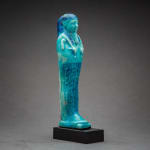Egyptian Faience Ushabti, 664 BCE - 525 BCE
Faience
height 14.7 cm
height 5 3/4 in
height 5 3/4 in
LK.008
Further images
There is no better object to epitomize the spirit of Ancient Egypt better than the ushabti, made in the form of a mummy. The Ushabtis were funerary figurines placed in...
There is no better object to epitomize the spirit of Ancient Egypt better than the ushabti, made in the form of a mummy. The Ushabtis were funerary figurines placed in tombs among the grave goods and were intended to act as substitutes for the deceased, should he be called upon to do the manual labor in the afterlife. They were used from the Middle Kingdom (around 1900 BC) until the end of the Ptolemaic Period, nearly 2000 years later. The ushabtis were believed to magically animate after the dead had been judged, and work for the dead person as a substitute labourer in the field of Osiris. Originally, a single ushabti was placed in a given tomb; but by the New Kingdom, the statues had come to be regarded as servants for the deceased rather than as a subsitute.
Its legs are a single unit, the arms vertical with the hands exposed appearing as if crossed. The effect is as if the figure is tightly wrapped in cloth, holding a hoe in each hand and a basket carried on the back. The basket recalls the rural, agrarian culture of the ushabtis.
Its legs are a single unit, the arms vertical with the hands exposed appearing as if crossed. The effect is as if the figure is tightly wrapped in cloth, holding a hoe in each hand and a basket carried on the back. The basket recalls the rural, agrarian culture of the ushabtis.







